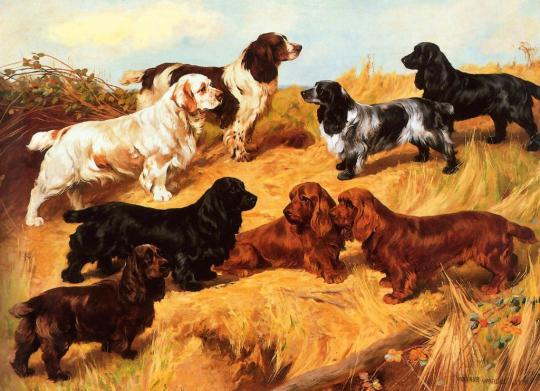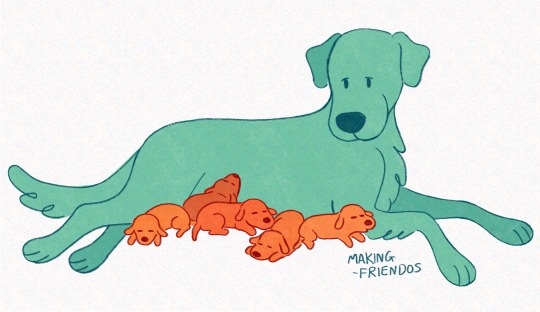Annie (human) & Acorn (dog) with special appearances from Fitz (cat). We love training, agility, and running around in the woods. Commenting and following from thesacredreznor.
Don't wanna be here? Send us removal request.
Text



The clouds on this day last summer were *chefs kiss*
141 notes
·
View notes
Text
Yes this was a very interesting episode! I wish she could have expanded on what low-resilience can look like beyond just chronic stress and related health issues.
Of course I immediately tried to classify Acorn. I’m fairly certain he’s high tenacity. He will go to the ends of the earth to access reinforcement in his environment— mostly toys and prey but also food to a certain extent. However it’s hard for me to harness his tenacity in a training context because what he really WANTS is to possess and dissect. For example, if I use a fur toy to play tug, he’ll enjoy that for a while but will get discouraged when he can’t “win” it. And I can’t trust him not to take and dissect if I let him have it. He has nice, cooperative toy skills with lower value toys, but only if there are few distractions around. Sorry I’m rambling. I guess I consider him high tenancy but in a more independent way than a typical sport dog?
Resilience is where I’m really torn. Acorn is reactive and generally struggles with emotional regulation—Fluoxetine doesn’t seem to help but that’s a post for another day. The thing is, he seems to bounce back well once the trigger is gone. He doesn’t have digestive issues or signs of chronic stress. He’s a super easy dog to live with and I don’t notice his day-to-day behavior changing depending on whether he’s had more reactive incidents or not. So maybe he falls into that gray area? But it feels weird to say that my reactive quirky dog doesn’t have low resilience?
I thought this episode of Cog Dog Radio was kind of interesting. I can see how this broad classification could be useful in understanding the general needs of individual dogs.
I would describe both Luca and Marceline as Low Tenacity/High Resilience dogs. They are both pretty well-adjusted and good at bouncing back from the vast majority of difficult stuff. They both have a specific line in the sand where they will stop working really hard for something. They're both pretty easygoing pets and if I was a better handler overall they would have been even more successful in the world.
Topaz meanwhile is definitely High Tenacity/Low Resilience. Her default temperament is Stressed Out™ but also Really Wants That Thing™ and Will Shout About It™. She is much better off on fluoxetine which brings her to a Medium Resilience.
I mean, it's not completely black and white. Marceline has low resilience on illness and injury and in certain training scenarios, but overall she most accurately falls in the LT/HR category. Luca meanwhile is really committed to attaining food and is also a little trigger happy with strange dogs, but I still wouldn't describe him as high tenacity.
16 notes
·
View notes
Text
It’s not that their animals are finally communicating—we always knew they were communicating. It’s that we’ve found this tool that acts as a catalyst to get us to listen more closely to what they’re saying, and now we can do that without the buttons. The act of putting my intention toward listening to my dog forced me to learn about a lot of things that make listening easier because I began to understand what I was hearing. Hearing Bunny speak to me in English was what truly inspired me to learn Dog, and our need for buttons has diminished as we start to just get each other as two animals in the room.
— Alexis Devine, I Am Bunny (2023)
Skill issue.
240 notes
·
View notes
Text

obligatory good photo before i upload the ones where he looks soooo stupid
136 notes
·
View notes
Text
I don’t think I’ve posted about this yet but I’m teaching a group class for the first time! I put together a 4 week class focused on recall— because it’s one of my fave training topics and because I wanted to experiment with a different format from the classes the head trainer is teaching.
Anyway, tonight was our third class and I’m feeling good about how it’s going. I really felt like tonight would be a good test, because the first two weeks focused more on foundations (name game, hand targets, collar grab game, and creating a positive CER for the recall cue). But all of the dogs did great. They’ve gone from inconsistent responses to their name to recalling from distractions!
I’ve also had the students do Susanne Clothiers relaxation protocol when I’m explaining concepts and it’s really made a difference. The dogs are able to settle and understand what to do when they’re not actively training. One of the biggest areas for improvement I’ve seen in the existing classes is that the dogs get frustrated and act up during downtime— I’m really hoping the improvements I’ve seen in this class will encourage the head trainer to adopt something similar for other classes.
Anyway just a lil brag because I needed a confidence boost. I worked hard on this curriculum and I’m pretty proud of it. One more class to go!
#I just always need to remind myself that I actually do help people and dogs#imposter syndrome sucks#and my previous employers really tore me down a lot too#so I need to give myself a lot of reassurance#but today was a great day#I also got to walk a puppy client that I did provide lessons with before#it was so fun and he’s doing so good
5 notes
·
View notes
Text

Arthur Wardle. Field Spaniels of the Twentieth Century. 1906. Oil on Canvas (Springer Spaniel, Field Spaniel, English Cocker Spaniel, Clumber Spaniel and Sussex Spaniel)
51 notes
·
View notes
Text

253 notes
·
View notes
Text

A copper retriever with her unoxidised puppies
98K notes
·
View notes
Text

This is my high-drive working line cat. He sits in my lap daily and has killed three (3) mice.
if we’re defining a “working/working-line” dog as “dog that must perform the tasks or purpose that it’s ancestors were selectively bred to do for its livelihood” e.g. a Great Pyrenees that lives outside 24/7 with its flock, a sighthound that goes out and hunts hares, a border collie who moves sheep every day on the farm, etc. then I am going to also say that this applies to companion breeds. a pekingese was bred for the job of sitting on its owners laps and to be a little watchful hot water bottle, therefore if you own a Pekingese today and it sits on your lap it is a working dog. Thank you for coming to my TED talk I will not be taking any further questions.
3K notes
·
View notes
Text

Keith Haring (American, 1958-1990), Untitled, May 1981. Felt-tip marker and paint pen on plastic, 18 x 24 in.
1K notes
·
View notes
Text
have definitely harped on this before but it really does just drive me absoluely insane when you see a dog breeder talking the big talk of "well i dont breed my dogs FOR DOG SHOWS because i dont BELIEVE in showing, dog shows are just BEAUTY PAGEANTS and mean NOTHING, i breed my dogs for WHAT MATTERS which means HEALTH and TEMPERAMENT and GREAT FAMILY PETS!!" and then you go to look at their dog for more info and it's the most poorly-structured off-type albino lilac double merle dog you've ever seen with zero titles and a single Embark panel as proof of health testing.
#I also love the claim of breeding for Good Temperament from people who do literally nothing with their dogs#very ‘trust me bro’ of them
511 notes
·
View notes
Text
Stealing this from a competitive obedience group because the answers have been fascinating. I would love to hear elaborations on methods/reasonings if you're up for it!
#I use one BUT I think this distinction is more about having food on your person or not?#because let’s be honest— your dog can smell if you have treats#that being said#as a reactive dog owner I almost always have a pouch if we’re out together#although if it’s a short trip and we’re unlikely to run into anyone I’ve been known to cram a few treats in my pockets instead#I do see the utility of skipping the pouch to help clean up your mechanics but I can also see reaching into a pocket having the same issues#now we have done a bit of work on training with reinforcement off my body#but that is mainly in an agility context and not so much for day to day stuff
136 notes
·
View notes
Text
Environmental enrichment (EE) can be used to enhance the environment of various animals. The aim of this pilot study was to determine the effects of seven EE activities (Bonding, Bubble machine, Conspecific play, Interactive toy, Playhouse, Stuffed food toy and Tug play) on dog behaviour, pre- and post-EE for dogs housed in an office environment during training as part of an assistance dog training programme. EE activities resulted in a significant increase in the frequency of relaxation behaviours (p < 0.01) and a significant reduction in alert (p < 0.01) and stress behaviours (p = 0.02). Results suggest various benefits of the different activities with Conspecific Play and Playhouse activities having the greatest overall positive behaviour change when compared to the other activities. The food-based EE activities (Interactive toy and Stuffed food toy) had the least behaviour change of all the activities provided. Findings will be of interest to pet owners, animal rescue centres, dog trainers and working dog organisations.
Effects of Environmental Enrichment on Dog Behaviour: Pilot Study
Effects of Environmental Enrichment on Dog Behaviour: Pilot Study (open access)
The various types of activities (most impactful highlighted)

24 notes
·
View notes
Text
genuinely what does scary dog privilege mean though. what are you privileged to do? menace people?
#I’m sure some ppl seeking ‘scary dog privilege’ have experienced some genuine trauma and want an intimidating dog#a lot of them just have true crime brainrot#or want a macho-looking dog but are for some reason unwilling to just say that
643 notes
·
View notes
Text
if you think bull terriers are ugly i hate you
321 notes
·
View notes
Text
What’s everyone’s dog/training goals for the New Year?! Put them in the tags i’ll start with mine :)
67 notes
·
View notes